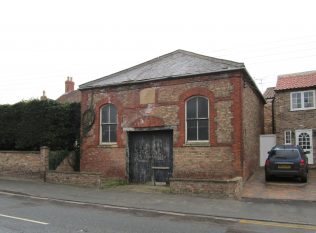East Riding of Yorkshire
Stamford Bridge and other chapel photos and information

Stamford Bridge Primitive Methodist chapel in use for storage
David Young
There is a book by D & S Neave called East Riding Chapels and Meeting Houses published by the East Yorks Local History Society, 1990, which contains a good number of photographs of East Riding Primitive Methodist chapels, and some snippets of information as well.
Here is my own photo of the Primitive chapel at Stamford Bridge. The wording over the door has been obliterated, and I could not read any date, name or text. The 1828 Wesleyan chapel further along the road is still in use.





Comments about this page
The 1851 Religious Census for Yorkshire records worship taking place in a dwelling house erected before 1800. On 30 March the morning congregation was 10, afternoon 12, and evening 25. Average congregations were morning 10, afternoon 40, evening 40. The Remarks record; “The Meetings are held in a poor Women’s dwelling house of only one ground Floor. Signed Israel Wake for Jane Wake.”
Borthwick Institute (part of York University):
Ref. MR/S/BPM: The foundation stone of the Stamford Bridge Primitive Methodist Chapel was laid in 1866, although a Primitive Methodist Society had been meeting in private houses in the village for some time and were recorded in the 1851 Census of Religious Worship. The site was granted by the Lord Mayor of York and the new chapel was built to accommodate 200 people.
Originally part of the York Circuit of the Primitive Methodist Connexion, it became part of the York First Circuit (renamed York, Monkgate Circuit from 1903) after the original Circuit was divided into two in 1883.
The chapel was closed by 1935 and later used as a store house.
The scope of the records is as follows: Records of Trustees’, including annual meeting minutes, 1875-1907 (with gaps), and treasurer’s cash book, 1866-1929; receipts, vouchers and financial correspondence, 1907-1922; certificate to use the chapel as a place of meeting for religious worship, 1868; correspondence about the sale of the chapel, 1927-1928.
Add a comment about this page